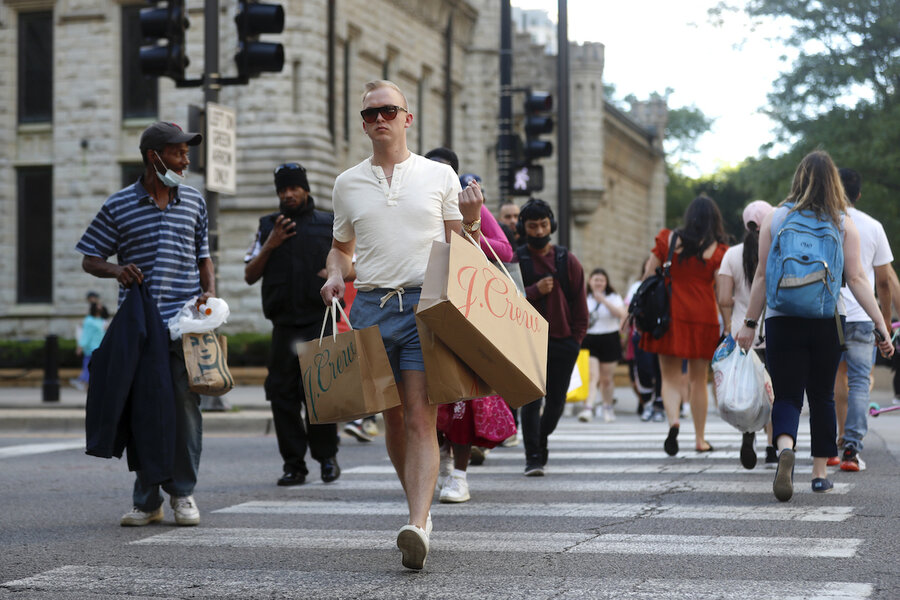The stores are ready, but will the shoppers come back?
Loading...
| New York
Americans are going back to one of their favorite pastimes: store shopping.
With more people getting vaccinated and dropping their face masks, retailers from Walmart to Macy’s are seeing an eager return to their stores after more than a year of their customers migrating online during the pandemic.
Marcia Williams, who lives in a Philadelphia suburb and who stuck to online shopping only during the height of COVID-19, went back to her local mall right after she was fully vaccinated last month. That was her first time in more than a year.
“I am definitely getting out,” said Ms. Williams, a hair and makeup artist who spent nearly $1,000 on clothing for herself and her three children during several buying trips. “I do feel more comfortable. I like the experience of trying on clothes. I love grocery shopping. It’s my outlet.”
The return to store shopping, highlighted in many retailers’ earnings reports in recent days, offers a big relief in part because fewer shoppers ask for their money back after making a purchase at the store – 8% compared with 25% for online, according to Forrester Research. And store customers tend to do more impulse buying. For clothing, for instance, 25% of purchases are done on a whim versus 16% online, says market research firm NPD Group Inc.
“Retailers want you in the store,” said Marshal Cohen, NPD’s chief industry advisor. “They need you to be in the store so you generate more traffic. Crowds bring more crowds. [Shoppers] buy more product.”
Still, retailers – particularly mall-based stores and other specialty stores that were struggling even before the pandemic – face plenty of challenges to keep customers coming back. They face stepped up competition online and from discounters that thrived in the last year. Experts also say that post-pandemic shoppers will be even more demanding: After being forced to stay close to home, they’re looking for better and convenient services and experiences.
Many retailers like Macy’s are still recovering from the pandemic, which forced them to temporarily close early last year, driving more traffic to big box stores that were allowed to stay open. And overall store traffic, while rebounding, is still not back to where it was two years ago.
Customer counts at overall stores surged 43.2% for the week starting May 10 compared to the year-ago period, but that number was still down 5.6% for that same period in 2019, says mobile-device location data from foot-traffic analytics firm Placer.ai. In clothing, customer counts soared more than two-fold for the same timeframe, but it was down 11.2% on a two-year basis. For big-box stores like Target, customer counts were up 5.3% for the same period but down 4.9% on a two-year basis.
Analysts are carefully watching the battered department store sector’s market share, which shrunk from 3% in 2019 to 2% last year and has remained at that figure for the first four months of the year, according to NPD. In comparison, discounters’ market share held steady at 21% last year from 2019 but ticked up to 22% for the early part of this year. Overall, market share for online retail rose to 26% last year from 23% in 2019.
The pandemic pulled forward the pace of online spending by about two years. Online shopping is expected to account for 21% of overall sales, or $794 billion, in 2020 compared to the prior year and should increase to 27%, or $1.1 trillion in 2023, Forrester says. However, online sales growth is slowing down, from 29.5% last year to a projected 15.6% this year and 10% next year.
Ms. Williams, who has a makeup line called Embellish Beauty and pivoted her consulting business to online during the height of the pandemic, says she will keep about 15% of her overall buying to online purchases like soap and other essentials.
Still, physical shopping is still not the same as it was pre-COVID-19. For example, retailers’ beauty counters are not yet allowing shoppers to try on makeup. Target said it will resume product sampling in stores this year where customers can take home individually wrapped items.
But store executives are feeling optimistic – for now.
Walmart, based in Bentonville, Arkansas, said last week that transactions in its stores were up for the first time in a year. At Target, sales at stores that have been open at least a year jumped 18% in the three-month period that ended May 1. That follows a 6.9% increase in the previous quarter.
That trend continued this week.
Best Buy, which had earlier said that comparable store sales might fall this year, revised their expectations Thursday, saying that those sales, a critical gauge of a retailer’s health, will likely rise between 3% and 6% in 2021.
Stores are seeing the return of shoppers “across all age demographics,” said CEO Corie Barry on Thursday in a conference call with industry analysts.
Many retail executives say that they are adding fresh new merchandise to welcome back shoppers. Target is planning to open Ulta Beauty shops in more than 100 Target stores by mid-2021. Kohl’s is getting ready to open Sephora beauty shops in 200 locations this fall. And Macy’s is leaning into such areas as toys, health and wellness, pet care, and food.
“Clearly, our customer is ready to get on with life,” Macy’s CEO Jeff Gennette told analysts last week. “We don’t see this as a short-term pop.”
This story was reported by The Associated Press.





